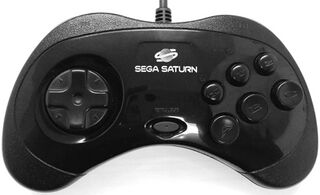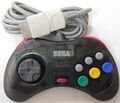Control Pad (Saturn)
From Sega Retro

| |||||||||||||||||||||||||||||||||||||||||||||
| Control Pad | |||||||||||||||||||||||||||||||||||||||||||||
|---|---|---|---|---|---|---|---|---|---|---|---|---|---|---|---|---|---|---|---|---|---|---|---|---|---|---|---|---|---|---|---|---|---|---|---|---|---|---|---|---|---|---|---|---|---|
| Made for: Sega Saturn | |||||||||||||||||||||||||||||||||||||||||||||
| Manufacturer: Sega | |||||||||||||||||||||||||||||||||||||||||||||
|
The Sega Saturn Control Pad, later known simply as the Controller in North America, is primary method of user input for the Sega Saturn. It is an evolution of the Six Button Control Pad for the Sega Mega Drive and was originally seen in 1994 along with the Saturn console.
Contents
Hardware
It has a circular D-Pad, a START button, and six face buttons; ![]() ,
, ![]() ,
, ![]() ,
, ![]() ,
, ![]() and
and ![]() . New to the Saturn is the addition of two shoulder buttons,
. New to the Saturn is the addition of two shoulder buttons, ![]() and
and ![]() , which replace the Mega Drive's "mode" button to bring the total number of buttons to nine. Like the Mega Drive Control Pad(s), it is ergonomically designed for maximum comfort.
, which replace the Mega Drive's "mode" button to bring the total number of buttons to nine. Like the Mega Drive Control Pad(s), it is ergonomically designed for maximum comfort.
The Saturn controller debuted in Japan in 1994 and remained largely unchanged throughout the lifespan of the console. In North America and Europe however, a different, much bulkier controller was released to supposedly accommodate for the "bigger hands" of western consumers. This "MK-80100" control pad is functionally identical to its Japanese cousin, but is slightly larger and has a peculiar concave D-Pad, not seen in a Sega console since. This particular model is often regarded to be worse than the Japanese variant, and was replaced entirely during the summer of 1996, cutting costs as the console was redesigned.
There are many slightly different colour variations of the controller, mostly to match the colour of the console. Japan initially received grey pads, but eventually saw white and clear varieties as well as those designed for V-Saturns and HiSaturns. In the rest of the world (bar Brazil), only black controllers were released.
The Control Pad saw an "upgrade" in the form of the 3D Control Pad, built as a response to the Nintendo 64's analogue joystick.
Differences in Control Pads
There were two primary versions of the Japanese controller though externally they look the same and were both numbered HSS-0101. However, internally they are completely different. Saturn controllers have a "plus-sign" shaped piece of plastic inside the controller under the D-pad. The pad is raised above this and that's what gives the pad the "rocker" feel as opposed to the mushy feel of a Nintendo 64 or PlayStation controller.
- First version. Easily breakable within hours of play. This plastic piece *is* plastic, and has ridges in it in such a way that it adds to its fragility. This version has a tan circuit board, and the primary chip on it is a regular "through-hole" IC with the markings sanded off. The board doesn't even say "Sega" on it, if I didn't know better I'd think it was a counterfeit (since one came with the system and the other was a separate controller it's near impossible, besides it still has the official plug that says Sega on it etc.).
- Second version. Durable. Plastic piece is now nylon, and no longer has ridges. Circuit board is now green, says "Sega" on it, and uses surface mount chip. With some minor changes all controllers were still like this until the end.
The gray Japanese controllers that Toys R Us sold were the second version, so it must have been changed relatively quickly. The switches for L/R are different on the two versions too, as they were softer on the first version. Parts between the two versions for the most part are not interchangeable, most of the plastic parts have been altered in one (non-obvious) way or another.
Magazine articles
- Main article: Control Pad (Saturn)/Magazine articles.
Gallery
Promotional material
Cool Pad JP TV advert
Physical scans
| Sega Retro Average | |||||||||
|---|---|---|---|---|---|---|---|---|---|
|
| 100 | |
|---|---|
| Based on 1 review | |
References
- ↑ 1.0 1.1 1.2 File:CVG UK 193.pdf, page 67 Cite error: Invalid
<ref>tag; name ":File:CVG UK 193.pdf_p67" defined multiple times with different content - ↑ 2.0 2.1 2.2 2.3 http://sega.jp/fb/segahard/ss/pad.html (Wayback Machine)
- ↑ File:AcaoGames BR 091.pdf, page 10





































